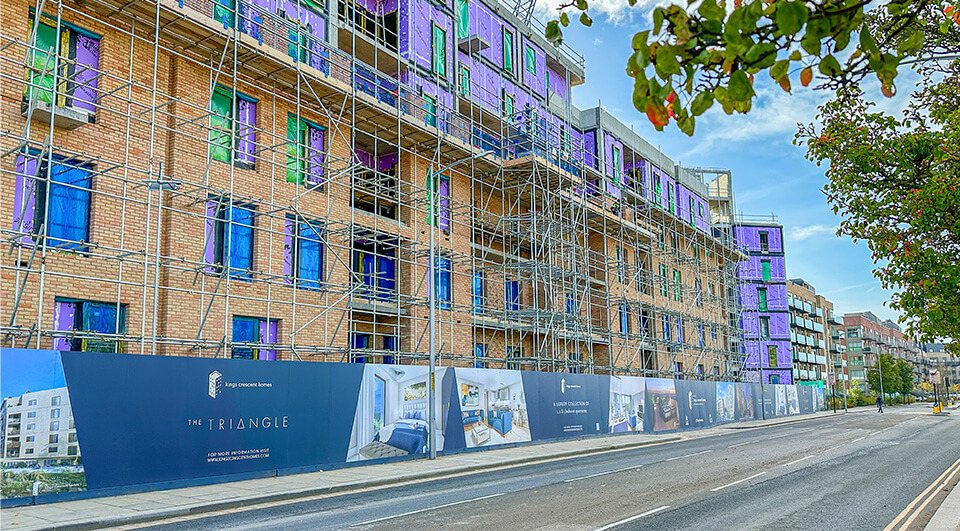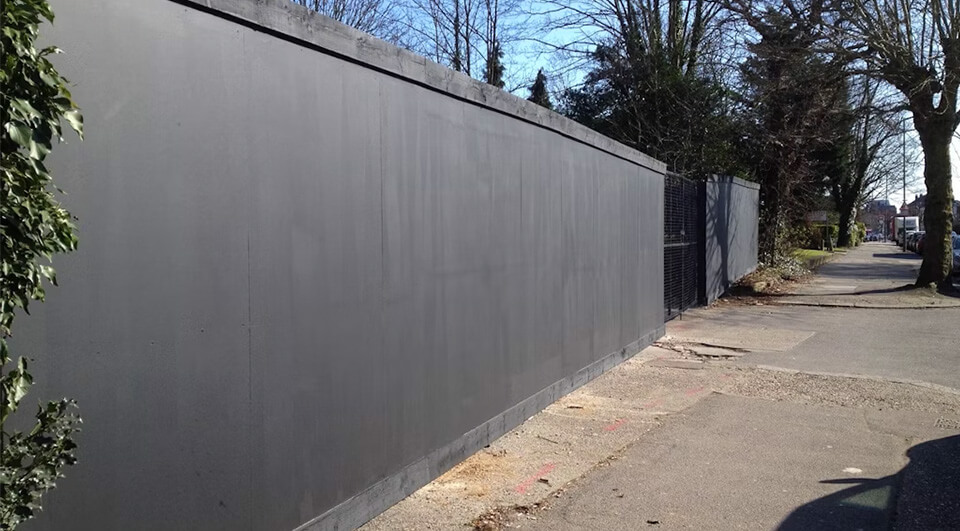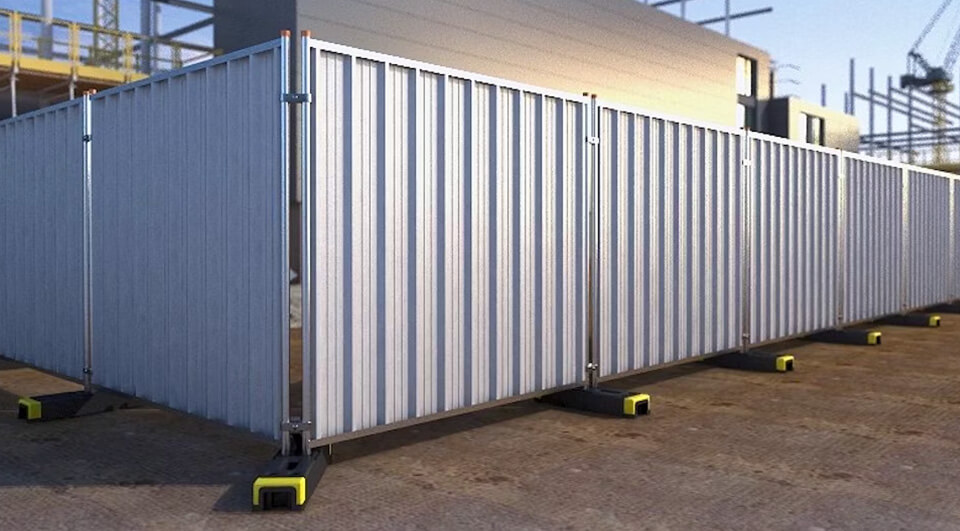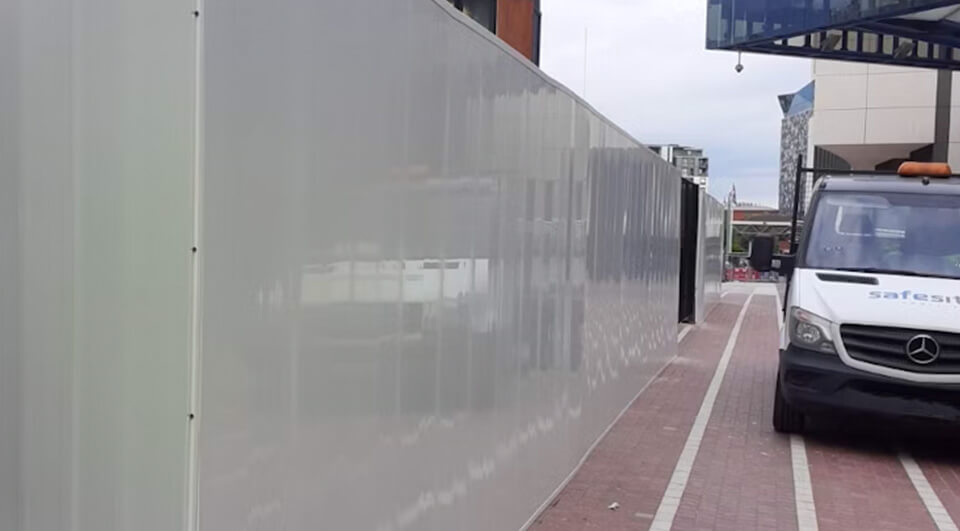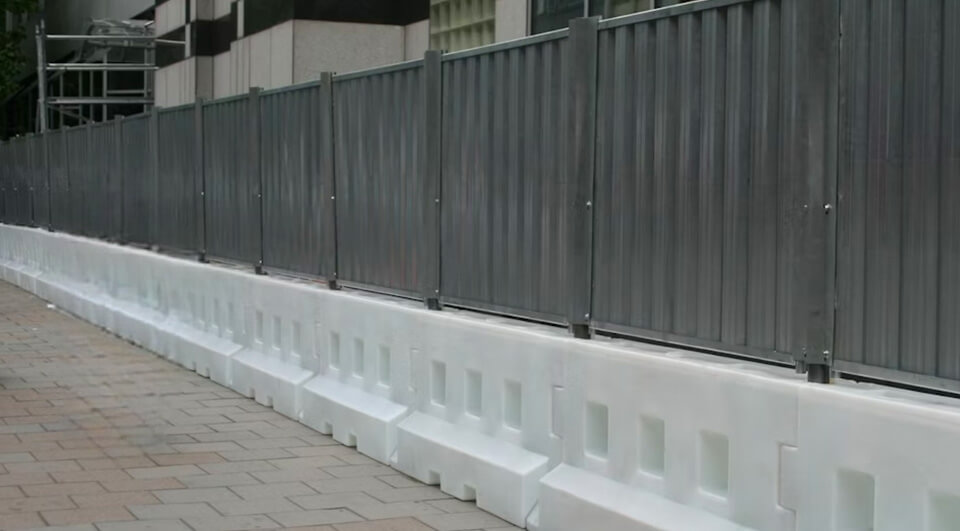Construction Hoarding is hugely popular for securing site perimeters on a long term basis. In this guide, we’ll cover everything you need to know about Construction Hoarding including benefits, requirements, suppliers and everything in between.
Jump to:
- What is construction hoarding?
- Why do you hoard a construction site?
- What are site hoardings used for?
- Types of Hoardings
- Site hoardings & planning permission
- Construction site hoarding requirements
- Site hoarding requirements: FAQs
- Is hoarding classed as temporary works?
- Who is responsible for site hoardings?
- When does a hoarding need to be in place?
- How do I get approval for a hoarding plan?
- How long does hoarding need to last?
- How strong does hoarding need to be?
- How big does hoarding need to be?
- How often do hoardings need to be maintained?
- Best Construction Hoarding Companies
- Where to buy Hoarding Signage
- Construction Hoarding Design Tips
What is Hoarding in Construction?
Construction hoarding is a temporary structure made from thick, sturdy boards and erected around the perimeter of a construction site. The primary purpose of hoarding is to secure the site and protect the local community from potential hazards associated with construction sites.
Construction site hoardings are usually made of wood or metal and often feature printed hoarding panels to advertise a construction project or brand.
Why do you hoard a construction site?
Construction sites are hoarded for the following reasons:
1. Safety
Site hoardings help protect the public from potential hazards associated with construction sites such as falling debris, machinery or uneven surfaces. Construction hoardings prevent unauthorised access, reducing the risk of accidents and injuries to passersby.
2. Security
Building site hoardings restrict unauthorised entry helping prevent theft and vandalism. Construction hoarding is particularly beneficial for sites that contain valuable materials and equipment.
3. Privacy and minimising disturbance
Site hoarding helps reduce the visual and noise disturbance caused by construction projects in the local community. This helps maintain a positive relationship between construction brands and nearby residents.
4. Legal compliance
Health and safety regulations often require construction sites to be hoarded to protect both workers and the public. See the section “Construction Site Hoarding Requirements” below for more information.
5. Advertising and Information
Construction hoarding offers great advertising space for construction brands or projects. PVC foam or Dibond hoarding panels are often printed to provide more information about project timelines and purpose.
What are Site Hoardings used for?
Site hoardings are used in a variety of locations where construction, renovation or other significant work is taking place. Here’s a breakdown of the common locations where different types of site hoardings are typically used:
1. Hoarding Building Sites
- Urban Constructions Sites – Hoardings are used around construction sites for new buildings, commercial offices and retail spaces. This helps protect the public and secure the site from unauthorised access.
- High-rise Developments – In highly populated areas, high-rise construction sites use hoardings to contain debris and protect passersby
- Public infrastructure projects – Hoardings help separate roadworks or railway projects from active traffic and pedestrian areas.
2. Shop Hoardings
- Retail Spaces and Shopping Centres – Shop hoardings are used during store renovations. They keep ongoing work private whilst minimising disruption to shoppers. Retail hoardings often serve as advertising space for the store or brand launch.
- Temporary Pop-Up Shops – Shop hoardings can help manage the set up process of stalls whilst preventing early access by the public.
- Street-Level Retail Construction – Shop hoardings are used at street-level stores to protect pedestrians from construction debris and provide a canvas for marketing messages.
3. Security Hoarding
- Demolition Sites – Security hoarding is crucial around demolition sites to contain debris, prevent unauthorised entry, and protect the public from potential hazards.
- Utility and Maintenance Work – Hoardings around areas where utilities like water, gas, or electricity are being repaired or upgraded ensure that only authorised personnel can access these high-risk areas.
- Event Spaces and Temporary Installations – Security hoarding is used during the construction of temporary structures for events, such as stages or seating, to secure the area and keep the public away until the site is safe
- Industrial and Sensitive Sites – Factories undergoing expansion or maintenance, as well as heritage and archaeological sites under restoration, use security hoarding to prevent unauthorised access and protect sensitive or hazardous areas.
Types of Hoardings
There are several types of construction hoarding, each designed to meet specific needs and requirements of construction sites. Below are the different types of construction hoarding:
1. Timber Hoarding
Timber hoarding is made from wooden panels, typically plywood, and is supported by timber posts and cross-bracing. This type of hoarding is versatile and can be easily customised to fit the dimensions of a site.
Advantages
- Cost-effective
- Suitable for uneven terrain
- Available dug-in or freestanding
- Can be painted or covered with graphics for advertising
- Easy to install and dismantle
- Can incorporate pedestrian and vehicle gates
- Timber is often ethically sourced to reduce environmental impact
Applications
Timber hoarding is a popular choice for smaller or medium-sized construction projects and events where a temporary yet sturdy barrier is needed.
Steel Hoarding
Steel hoarding consists of metal panels, usually made from galvanised steel, which are attached to steel posts and braces. These hoardings provide a more robust and secure barrier compared to timber.
Advantages
- Durable & weather-resistant
- Fire and arson resistant
- Ideal for long-term projects
- Excellent security
- Can be freestanding and very quick to set up
- Can incorporate pedestrian and vehicle gates
- Available in a variety of colours for high visibility
- Offers a good range of accessories to allow lighting and signage
Applications
Steel hoardings are typically used on large construction sites and projects that require a strong, permanent barrier to protect against theft, vandalism or unauthorised access.
Plastic Hoarding (UPVC)
Plastic hoarding, often made from UPVC (unplasticised polyvinyl chloride) consists of lightweight yet durable panels that can be quickly assembled.
Advantages
- Lightweight & easy to transport
- Weather resistant
- Recyclable
- Easy to clean and maintain
Applications
Plastic hoarding is often used in situations where aesthetics and ease of installation are important, such as in public-facing areas, retail spaces, and temporary construction sites.
Free-standing Hoardings
Free-standing hoardings are not fixed into the ground but are instead supported by weighted bases. This type of hoarding can be made from various materials, including timber, steel, or plastic.
Advantages
- Can be quickly moved or adjusted
- Easy to empty, dismantle and redeploy
- Often seen as the go-to system for short-term use
- Ideal for sites with temporary access requirements
- Suitable for sites where ground cannot be disturbed
- Compatible with vehicle or pedestrian gate systems
Applications
Free-standing hoardings are commonly used in areas where a temporary or movable barrier is needed, such as events, exhibitions, or short-term construction projects. They are also suitable for use on hard surfaces, like concrete or asphalt, where traditional hoarding cannot be installed.
Site hoardings: do you need planning permission?
The necessity for planning permission for site hoardings is dependent on location, size, duration and purpose of your hoardings. Here’s a detailed overview of when you might need planning permission for site hoarding in the UK:
When Planning Permission is Required
1. Location and Impact
Public Highways and Spaces – If the hoarding is to be erected on or adjacent to public highways, pavements, or other public spaces, planning permission is typically required. This ensures that the hoarding does not obstruct public access or create safety hazards.
Heritage or Conservation Areas – In areas designated as conservation areas or near listed buildings, planning permission is required to ensure that the hoarding does not negatively impact the historical or aesthetic value of the area.
2. Height and Size
Height Restrictions – The height of the hoarding is a critical factor. For instance, hoardings that exceed a certain height (commonly 2 metres) may require planning permission. The exact height threshold can vary, so it’s essential to check local planning regulations.
Length and Structure – Very long or large hoardings may also require planning permission, especially if they affect the visual amenity of the area or are likely to have a significant impact on the surrounding environment.
3. Duration
If the hoarding is intended to be in place for more than 28 days, planning permission is generally required. Short-term hoardings (typically for less than 28 days) might not need planning permission but must still adhere to other regulations.
4. Advertising and Signage
If the hoarding includes advertising or promotional signage, separate permissions might be needed. Advertising on hoardings is subject to regulations under the Town and Country Planning Act 1990, and you may need to apply for an advertisement consent.
When Planning Permission May Not Be Required
1. Private Land
Hoardings erected entirely within private land boundaries, which do not affect public spaces or rights of way, may not require planning permission. However, it is still advisable to check local regulations.
2. Minor and Temporary Installations
Hoardings for very short-term projects might not need planning permission. This generally applies to installations that are up for less than 28 days. Nonetheless, you should verify this with local authorities.
It’s essential to consult with the local planning authority or council to confirm whether planning permission is required for your specific site hoarding. They can provide guidance based on local regulations and the specifics of your project.
Construction Site Hoarding Requirements
Health and safety regulations related to site hoardings in the construction industry are designed to protect both workers and the public from potential hazards. Site hoardings act as temporary barriers that surround a construction site, ensuring safety, security, and minimal disruption. Here is a comprehensive overview of the health and safety regulations for construction site hoardings, including when hoarding is required.
When Hoarding is Needed
Health and safety regulations mandate the use of hoardings on construction sites in various circumstances to protect the public and workers. Hoarding is typically required when:
1. Preventing unauthorised access
Hoarding must be installed around construction sites to prevent unauthorised access, reducing the risk of accidents and injuries. This is crucial in urban areas or high-traffic locations.
2. Protecting the Public from Hazards
When construction activities pose risks such as falling debris, dust, noise, or the use of heavy machinery, hoardings are needed to create a safe barrier between the work site and the public.
3. Ensuring Privacy and Minimising Disturbance
Hoarding is necessary for projects in residential or commercial areas to shield ongoing construction activities, reducing visual and noise disturbances to nearby residents and businesses.
4. Compliance with Local Regulations
Local building codes and regulations often require hoardings to be erected around certain types of construction projects, such as high-rise developments, public infrastructure works, or sites undergoing demolition.
To fully understand whether you need construction hoarding on your site, we recommend reading up on the following regulations:
- Health and Safety at Work etc. Act 1974
- Construction (Design and Management) Regulations 2015
- Health and Safety Executive (HSE)
Construction Hoarding Requirements: FAQs
Below are some of the most common questions when it comes to installing construction hoardings.
Is hoarding classed as temporary works?
Yes, hoarding is generally classed as temporary works in the construction industry. Temporary works are structures or systems that are required to support construction activities but are not intended to become a permanent part of the building or infrastructure.
Heras fencing and Hoardings are considered temporary works because they are erected to provide safety, security, and privacy for the duration of a construction project and are removed once the project is completed.
Who is responsible for Site Hoardings?
Construction Hoarding is the responsibility of the principal contractor on the project. Sometimes a contractor will design and construct the site hoarding themselves, or they may employ a subcontractor.
As Hoardings are classed as temporary works, it is common practice for contractors to employ a Temporary Works Coordinator (TWC). TWC’s oversee the construction and removal of any hoarding. TWC’s are also responsible for scaffolding and any other temporary structures that are used on site.
A qualified TWC is often recommended to help you avoid mistakes that could lead to safety hazards if left unaddressed.
When does a hoarding need to be in place?
Construction site hoardings need to be in place before any project can start. During risk assessment the principal contractor or TWC will need to determine the outline and perimeter of the site. They will then work out what type of hoarding and layout is necessary. Once this has been approved, the hoarding can be built and construction can begin.
How do I get approval for a hoarding plan?
Once plans have been drawn up for the structural design of construction hoarding, a relevant design check certificate will need to be obtained. These can be granted by any qualified individual other than the person who designed the hoardings – often a Temporary Works Coordinator.
The person responsible for granting a design check certificate will need to ensure hoarding plans conform to safety guidelines and meet the requirements of the site.
How long does hoarding need to last?
The lifespan of site hoarding will need to be agreed upon by the client, contractor and temporary works coordinator. Hoardings will sometimes need to move or change shape which will need to be factored into this agreement.
Hoardings should remain in place as long as the construction work is ongoing. This can range from a few weeks to several months or even years, depending on the scale of the project.
How strong does hoarding need to be?
The strength required for construction hoarding depends on several factors, including the site’s specific conditions, the duration of the hoarding’s use, and the potential risks it needs to mitigate. Here’s a detailed look at the strength considerations for site hoardings:
1. Structural Stability
Weather Conditions – Hoardings must be strong enough to withstand various weather conditions, such as high winds, heavy rain, and snow. This is especially important in exposed or coastal areas where wind speeds can be higher.
Material Strength – The chosen material (timber, steel, plastic, etc.) must be strong enough to support its own weight and any additional loads or forces it may encounter. For example, steel hoardings provide high strength and durability, while timber may need reinforcement.
2. Impact Resistance
Vandalism and Accidents – Hoardings should be robust enough to resist impacts from vandalism or accidental collisions. This includes being able to withstand the force of thrown objects or accidental contact by vehicles.
Construction Debris – If there is a risk of falling debris from the construction site, the hoarding needs to be sufficiently strong to contain or deflect these materials to protect the public and workers.
3. Height and Load-Bearing Capacity
Height Requirements – The height of the hoarding can affect its stability. Higher hoardings generally need to be stronger and better anchored to prevent toppling or bending. For instance, a hoarding over 2 metres in height might require additional bracing or reinforcement.
Load Distribution – Hoardings must be designed to distribute loads evenly, including any additional loads from signage or attached elements. This ensures that the hoarding remains stable and secure throughout its use.
4. Design and Installation
Foundation and Anchoring – The strength of the hoarding is also dependent on its foundation and anchoring. Proper installation techniques must be used to ensure that the hoarding is securely fixed in place and can handle expected loads and forces.
Bracing and Supports – For taller or longer hoardings, additional bracing or support structures may be necessary to enhance stability and prevent leaning or collapse.
How big does construction site hoarding need to be?
In general, construction site hoardings need to be at least 2 metres high to effectively provide a barrier between the construction site and the public. This height helps prevent unauthorised access and protects pedestrians from falling debris.
For taller construction sites, such as high-rise buildings, or where additional security is needed, hoardings may need to be higher than the minimum requirement. In some cases, heights of up to 3 metres or more might be necessary.
How often do hoardings need to be maintained?
Hoardings should be inspected regularly, typically every few weeks, to ensure they remain in good condition. This helps identify any issues early, such as damage, wear, or structural weaknesses.
A contractor or Temporary Works Coordinator will typically draw up a schedule for inspection and ensure any maintenance work takes place immediately.
Best Hoarding Companies
When it comes to securing your construction site with reliable, durable, and aesthetically pleasing hoardings, Safe Site Facilities stands out as the premier choice. SafeSite offers a range of hoarding solutions tailored to meet the diverse needs of construction projects.
Site Hoarding Options & Costs
SafeSite offers a range of hoarding options below. The price of construction hoarding often varies based on size, location, installation and delivery options. The best way to get a price is to contact SafeSite for a free quote.
1. Site Timber Hoarding
Timber hoardings are a classic choice for construction sites, combining durability with versatility. Costs vary based on the height and length of the hoarding, as well as customisation options.
2. Site Steel Hoarding
Steel hoardings provide superior strength and security, making them ideal for high-traffic and high-risk areas.
Higher in price compared to timber. However, their long-term durability and reduced maintenance needs can result in cost savings over the life of the project.
- Hire from £2.80 per unit/week ex. VAT
- Buy from £60.50 per unit ex. VAT
3. Water-filled Hoarding
Water-filled hoardings offer a modern and flexible solution with a focus on stability and safety. Water-filled hoardings offer a competitive pricing structure with the added benefit of lower transportation costs due to their modular design.
4. Reusable UPVC Hoarding
Reusable UPVC hoardings combine durability with sustainability, providing a cost-effective and eco-friendly option. The initial cost of UPVC hoardings may be higher, their reusability and low maintenance requirements can result in significant savings over time.
Where to buy Hoarding Signage
If you’re looking to advertise your brand or project across your construction hoarding, look no further than Monster-Mesh.
We offer a full-service advertisment hoardings or supply-only printed Hoarding panels with free artwork and design support. Printed in sheets, custom Hoarding signage comes fitted with holes for you to easily fit to your construction hoarding.
Dibond Hoarding Panels
Dibond hoarding panels are a popular choice for construction sites due to their durability. Dibond panels are 3mm thick and start from £69.75 per panel.
Benefits:
- 244cm x 122cm as standard or available in custom sizes
- High-visibility and weather resistant
- Suitable for outdoor construction projects
- Range of finishes available
- Easy to install
- Matching headers and kickers available
PVC Foam Hoarding Panels
Printed PVC foam hoarding panels are ideal for internal hoardings or short-term outdoor use. Available 3, 5 or 10mm thick and start from £45.31 per panel.
Benefits:
- 244cm x 122cm as standard or available in custom sizes
- Full-colour UV printed
- Available laminated or unlaminated
- Simple to install
- Headers and kickers available on request
How to order printed Hoarding panels
Email info@monster-mesh.co.uk with the following details:
- Artwork brief including images and logos
- The overall size of your hoardings as well as individual panel sizes
- Any images of your hoardings in place
- How many panels you require
- Whether your hoardings level up or down in places
- If there are any windows or doors in your hoardings
- What finish you’d like on your hoardings
- Invoice and delivery address
If you have any questions, don’t hesitate to get in touch.
Construction Hoarding Design Tips
When it comes to designing effective construction hoarding, visibility and clarity are paramount. Ensure your hoarding design incorporates large, legible signage that provides essential information, such as project details, safety instructions, and contact information.
Opt for high-contrast colours and bold fonts to make the information easily readable from a distance. This not only enhances safety but also improves the overall appearance and professionalism of the site.
For more in-depth tips and creative ideas to elevate your construction hoarding, check out our 6 Top Tips for Construction Hoarding.
Construction hoardings are a strong, sturdy yet relatively versatile solution for site safety and security. Site hoardings create a visual barrier between your project and the wider public maintaining a positive relationship within your community.
To elevate the visibility of your construction site, explore our range of printed hoarding panels or construction branding. If you need any support, don’t hesitate to email info@monster-mesh.co.uk or call 01709 432 001.








